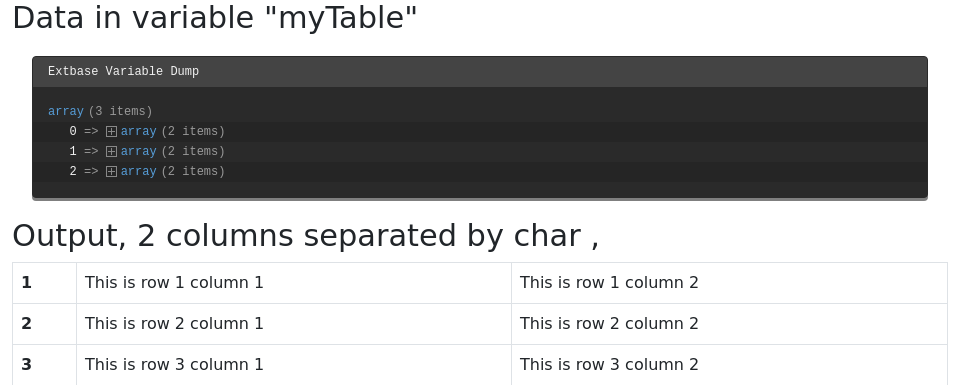Attention
TYPO3 v11 has reached end-of-life as of October 31th 2024 and is no longer being maintained. Use the version switcher on the top left of this page to select documentation for a supported version of TYPO3.
Need more time before upgrading? You can purchase Extended Long Term Support (ELTS) for TYPO3 v10 here: TYPO3 ELTS.
CommaSeparatedValueProcessor
The Comma allows to split values into a
two-dimensional array used for CSV files or
tt_ records of CType table.
The table data is transformed to a multi-dimensional array, taking the delimiter and enclosure into account, before it is passed to the view.
Options:
if
if
-
- Type
- if condition
- Required
- false
- Default
- ''
If the condition is met, the data processor is processed.
fieldName
fieldName
as
as
-
- Type
- string
- Required
- false
- Default
- defaults to the fieldName
The variable's name to be used in the Fluid template.
maximumColumns
maximumColumns
fieldDelimiter
fieldDelimiter
fieldEnclosure
fieldEnclosure
Example: Transforming comma separated content into a html table
Please see also About the examples.
In this example, the bodytext field contains comma-separated
values (CSV) data. To support different formats, the separator between
the values can be specified.
This example is also described in-depth in TYPO3 Explained: Extended content element example.
Example data in the field bodytext
Field bodytext in table tt_:
"This is row 1 column 1","This is row 1 column 2","This is row 1 column 3"
"This is row 2 column 1","This is row 2 column 2","This is row 2 column 3"
"This is row 3 column 1","This is row 3 column 2","This is row 3 column 3"TypoScript
We define the data property to use the
Comma:
tt_content {
examples_newcontentcsv =< lib.contentElement
examples_newcontentcsv {
templateName = DataProcCsv
dataProcessing.10 = TYPO3\CMS\Frontend\DataProcessing\CommaSeparatedValueProcessor
dataProcessing.10 {
if.isTrue.field = bodytext
fieldName = bodytext
fieldDelimiter.field = tx_examples_separator
fieldEnclosure = "
maximumColumns.field = imagecols
as = myTable
}
}
}The Fluid template
In the Fluid template, you can iterate over the processed data. "myContentTable" can
be used as a variable {my inside Fluid for iteration.
<html data-namespace-typo3-fluid="true" xmlns:f="http://typo3.org/ns/TYPO3/CMS/Fluid/ViewHelpers">
<h2>Data in variable "myTable"</h2>
<f:debug inline="true">{myTable}</f:debug>
<h2>Output, {data.imagecols} columns separated by char {data.tx_examples_separator}</h2>
<table class="table table-bordered">
<f:for each="{myTable}" as="columns" iteration="i">
<tr>
<th scope="row">{i.cycle}</th>
<f:for as="column" each="{columns}">
<td>{column}</td>
</f:for>
<tr>
</f:for>
</table>
</html>Output
Using maximum limits the amount of columns in the multi dimensional array.
In this example, the field data of the last column will be stripped off. Therefore the output would be:

